We’ve never been shy about saying how much we love boondocking. It’s far and away our favorite way to camp, and we’ve long encouraged everyone to try it. One of the main reasons why many people are intimidated by the idea of boondocking is the limitation on power. We get that – we’re fairly big power consumers ourselves. But, with a decent house battery system, (different for everyone), you can have ample power for camping off the grid. So, in today’s post we’re talking about the central piece of a good off-grid power system – the best RV battery for boondocking.
- 1) What is Boondocking?
- 2) What Are the Different Types of Batteries for Boondocking?
- 3) What is the Best Battery Setup for an RV?
- 4) Should I Wire 6V Golf Cart Batteries in Series or Parallel?
- 5) How Many Amp Hours Do I Need for Boondocking?
- 6) How Do I Charge My RV House Batteries?
- 7) What to Look for in the Best RV Battery for Boondocking
-
8)
What Are the Best RV Batteries for Boondocking?
- 8.1) Battle Born LiFePO4 Deep Cycle Battery
- 8.2) Xantrex 12V Lithium-Ion Battery
- 8.3) Fullriver 6V AGM Battery
- 8.4) Optima OPT8016-103 Batteries D34M BlueTop Starting and Deep Cycle Marine Battery
- 8.5) VMAX XTR6-235 6Volt 235ah AGM Golf Cart Battery
- 8.6) Trojan T-105 GC2 6V Deep Cycle Flooded Lead Acid Battery
- 9) Enjoy Your Time Camping Off the Grid
What is Boondocking?
For those who may be unfamiliar with boondocking, the easiest way to describe it is camping off the grid. This means that, unlike in an established campground or RV park, you won’t be connected to amenities like shore power for your electrical needs and city water & sewer.
Hooking up at a campsite is great – you have all the power you need, plenty of water for showering, and you can run everything from a microwave oven, to air conditioners, to electric heaters, coffee pots, and blow dryers, and you don’t have to conserve power or water. You can even run a washer and dryer if your rig has them.
But there are remote camping locations off the grid that offer a different sort of power and even more incredible amenities…for instance, the power of being in nature where the quiet is interrupted only by birds, crickets, loons, and coyotes. Amenities like magical vistas as far as the eye can see. Waking up beside the ocean or next to a lake, and drinking your coffee while you watch the rising sun and listen to the waves lapping the land.
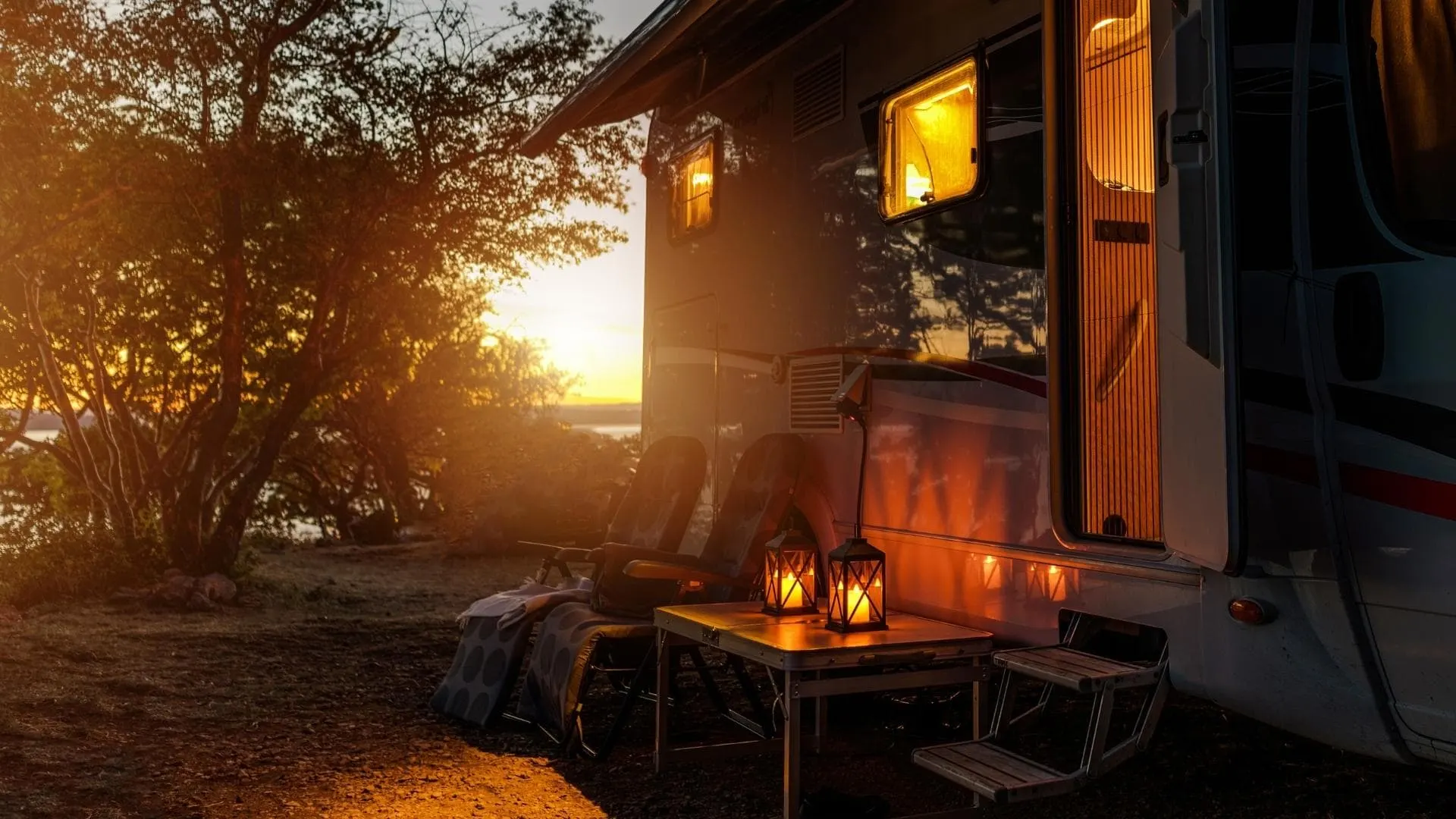
There’s nothing in the world quite like your living room being nature itself.
Boondocking offers experiences commercial campsites can’t quite match. But, if you’ve got work to do on a computer or tablet, or you can’t live without your favorite electric coffee maker, or the summer sun is hot and uncomfortable, you’ve got questions about how to power the things you need while you’re off the grid.
So, now that we know what boondocking is, let’s take a look at the best batteries for boondocking, to get you the power you need to spend a night or ten in the heart of nature.
What Are the Different Types of Batteries for Boondocking?
Before we get into what is the best RV battery for boondocking, let’s take a look at the different types of house batteries available for RVers. They’re not all the same and they all function and perform differently. Which type of RV battery is best for you, and your boondocking needs, depends on a number of factors, (not the least of which is budget, as is always true for all of us).
Lithium Batteries (Lithium Iron Phosphate)
The gold standard for RV boondocking with solar as your energy source is the lithium battery. Lithium batteries have achieved this elite status because they perform best in general use for a number of reasons:
- They’re lighter weight than other batteries types.
- They’re less affected by ambient temperature (so they perform more consistently in both warm and cold climates).
- They require no routine maintenance.
- They charge faster due to less resistance to charging… they don’t require the typical three-stage charging cycle needed to overcome the charging resistance of lead-acid batteries.
- They supply more power for your money because they can be drained to 100% without suffering damage. All of the forms of lead-acid batteries (flooded, AGM, and gel) have a limitation on the amount of power that can be drawn from them without damaging them… typically a maximum of 50% of their capacity. Lithium batteries don’t have this limitation.
- They don’t need to be charged to 100%. Lead-acid batteries need to be 100% recharged on a regular basis in order to properly and fully return the sulfur that’s accumulated on the lead plates back into solution. Failing to do so can reduce both the capacity and lifespan of the batteries. Lithium doesn’t have this requirement.
- They don’t outgas hydrogen during charging (the way flooded lead-acid batteries do), so they don’t need to be installed in outdoor or vented compartments, giving greater flexibility with their placement.
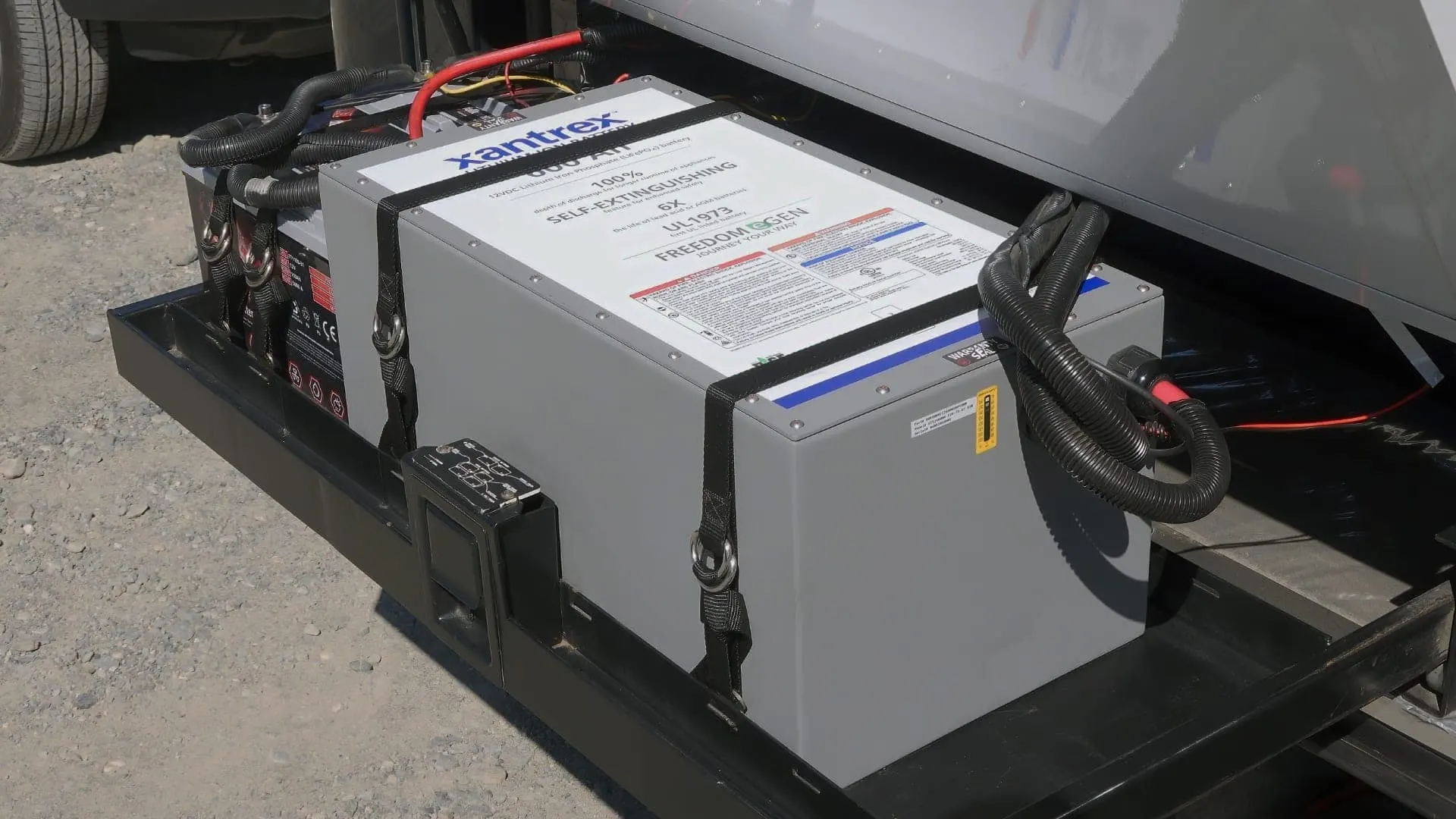
We have a lithium battery from Xantrex – a 600Ah Freedom eGen – that works with our 1,300W solar system. But Xantrex also makes 12V lithium drop-in batteries.
Lithium batteries are safe for two primary reasons. First, the Lithium-Iron-Phosphate (LiFePO4) chemistry is extremely stable, both thermally and chemically. This makes them difficult to ignite in the event of mishandling (especially during charging). Second, they’re typically designed with built-in battery management systems (BMS), that properly control the charging/discharging processes in order to ensure they remain well within safe parameters.
The one real drawback of lithium batteries is their initial cost. They’re very expensive to purchase, but once you have them, they’ll likely outperform any other battery you could install, for significantly longer. But they do require a lot of upfront cash.
So, let’s take a look at some other, more budget-friendly options.
Gel
Gel batteries are the next most expensive RV house batteries. A gel battery is self-contained and thus maintenance free. Gel batteries use similar electrolytes to those found in flooded lead-acid batteries, however unlike flooded lead-acid batteries there are no liquids that need to be maintained (or that can spill) in gel batteries.
Gel batteries have long been popular with serious off-roaders because they’re rugged and durable, and aren’t sensitive to hot and cold temperatures.
The downsides of gel batteries is that they’re fairly expensive and they aren’t as efficient as other batteries in terms of charging. They tend to take a long time to charge and are fairly sensitive to the charging process. Plus, like all lead-acid chemistry batteries, they have a 50% limit on their useable power… so a 100Ah battery can only supply 50Ah before it should be recharged.
AGM
AGM (absorbed glass mat) batteries are lead-acid batteries that are fully contained. Essentially, “AGM” means that the liquid inside the batteries is absorbed by glass mats, meaning that there is no liquid that can spill out regardless of how the battery is positioned, and it’s maintenance-free because you don’t have to check and top off liquid contained in the cells (unlike a typical flood lead-acid battery).
Less expensive than both lithium and gel batteries, AGM batteries are quite efficient, can handle hot and cold temperatures, have a pretty low discharge rate, and are less expensive to purchase than lithium batteries. The do, however, have a 50% limit on their useable power, so need twice as many AGM batteries to equal lithium’s power capacity.
Because they’re fully contained, they don’t off-gas hydrogen, allowing them to be placed inside a vehicle, one of the reasons why AGM batteries have been popular with RVers and van builders for years.
Flooded Lead-Acid
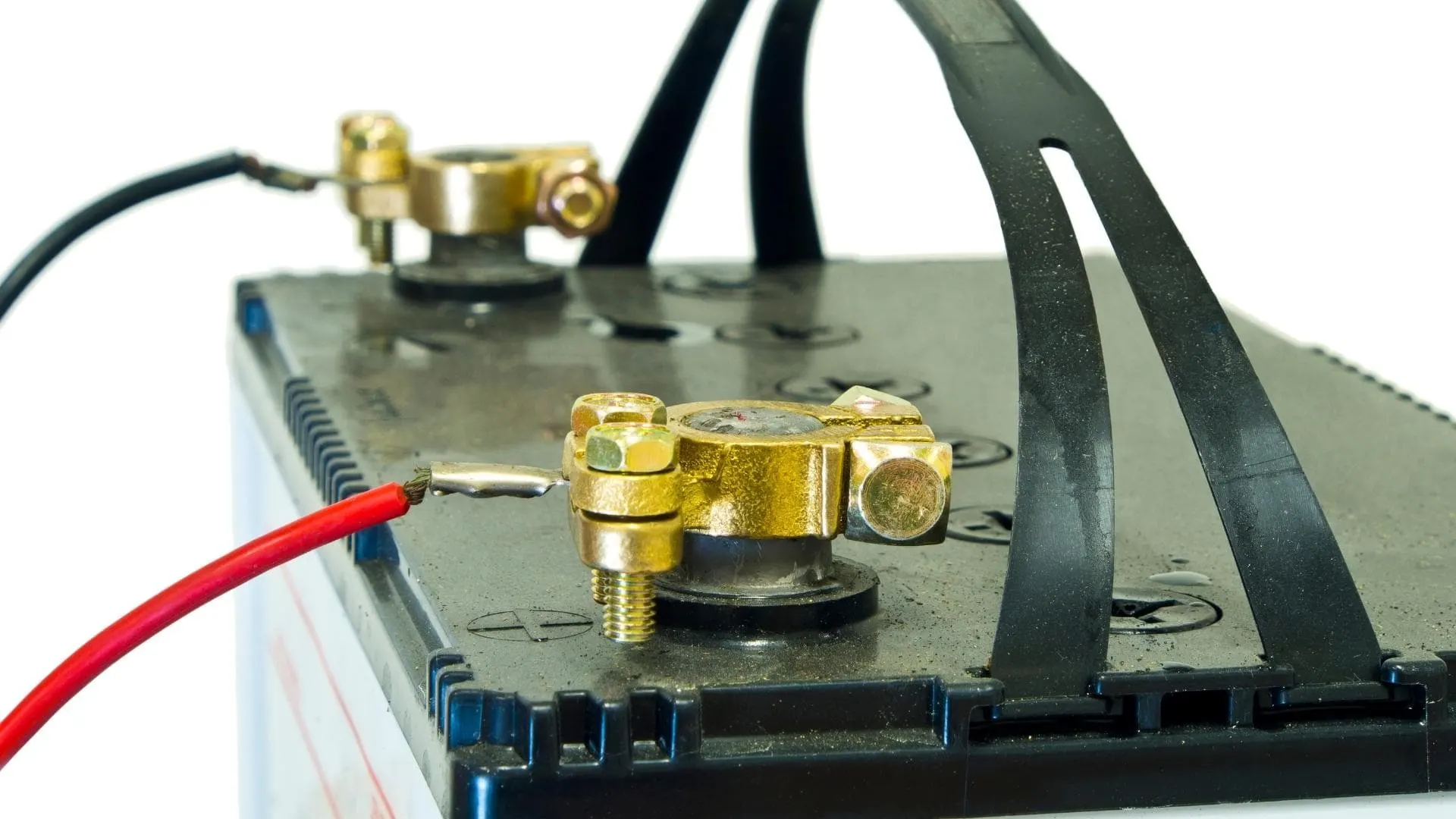
The flooded lead-acid battery is the least expensive battery option for boondocking. These will work fine to supply power to your RV, though they do have several limitations.
Flooded lead-acid batteries are typically the least expensive RV batteries. However, they require venting because they off-gas hydrogen during charging (which is an explosion hazard), they require routine maintenance (namely the topping off of the electrolyte solution contained in their cells), and they have the 50% capacity limitation of all lead-acid batteries.
If you don’t boondock often or for very long periods of time, (weekend campers, for example), flooded lead-acid batteries offer the best bang for your buck, providing you with the least expensive power available in an RV house battery, and likely are the choice for you as the best RV battery for boondocking!
However, it’s important to note that flooded lead-acid batteries are very heavy and, in addition to requiring venting and maintenance, they generally aren’t tolerant of temperature extremes. Leave a lead-acid house battery in your rig through the winter in a climate where freezing temps are a thing, for instance, and you’ll be buying yourself a new house battery come spring.
On the other hand, if you remove your flooded lead-acid batteries from the rig while it’s in winter storage, and you store them properly, they’ll store well for a long period of time.
What is the Best Battery Setup for an RV?
As noted above, lithium-ion batteries have rapidly become the gold standard for providing power to an RV, and are often listed as the one-and-only choice as the “best RV battery for boondocking”, but there’s no getting around the fact that they’re expensive and, so, might not be the best choice for YOU.
If lithium batteries are too heavy on the budget, AGM or 6-volt deep cycle lead-acid batteries can also work very well in this application.
Should I Wire 6V Golf Cart Batteries in Series or Parallel?
If you opt for 6V deep cycle (golf cart) batteries as your choice of the best RV battery for boondocking, you can choose to wire two or more together, either in series or in parallel. But, here’s what you need to know:
Wiring in series means wiring + to – (positive to negative). This adds the two batteries’ voltages together, but doesn’t add their capacity. So, two 105Ah 6V batteries wired in series are equal to one larger 12V battery… but even combined will only offer 105Ah capacity.
Wiring in parallel means wiring + to + (positive to positive), and – to – (negative to negative), which adds the capacity of the batteries together, but doesn’t affect voltage. Here, two 105Ah 6V batteries wired in parallel will create one larger 6V battery, but their capacities will be combined for a total of 210Ah.
This is why many RVs come with a bank of four 6V batteries wired together. They’re wired in what’s called series-parallel: 2 batteries are wired together in series to create one larger 12V battery, then that pair is wired in parallel to the second pair (which are also wired to each other in parallel) to increase the total amp-hour capacity of the battery bank.
How Many Amp Hours Do I Need for Boondocking?

If you only camp off the grid for a couple of days at a time and all you need to power are your RV lights (especially if they’re LEDs!), and maybe a vent fan and a few devices, you can get by very easily with a small battery bank.
Now this is a question that’s not easy for us to answer, because it really depends on your power consumption over the duration of time you’ll be boondocking, as well as the number of batteries you’ll have and how you intend to charge them.
Using ourselves as an example, we work full time from our RV. We use a fair amount of power by necessity, just based on our work alone. This is because we’re running a fair amount of technology 24/7, as you will have noticed in our most recent post on the upgrading of our tech cabinet in 2021.
We also have a large rig, a Class A diesel pusher with lots of appliances, including a fairly power hungry residential refrigerator that requires us to leave our inverter on 24/7/365. Granted, we don’t run a lot of our other appliances while we’re boondocking. We conserve power to the degree that it’s possible to do so and continue working full time running a few businesses from our rig parked in the literal middle of nowhere. You can get more information on how we do this in our Complete Guide to Class A RV Boondocking.
We also have 1,300 Watts of solar on our roof, and we have auto-tilting mechanisms to take full advantage of the sun.
If by contrast you’re heading out on a weekend boondocking trip, and all you need to do is power your LED RV lights, your rig’s water pump, your roof vent fan to keep things cool, keep your phones and tablets charged, and watch a little streaming television when you’re relaxing before bed, then you can surely get by with a couple of flooded lead-acid house batteries very easily.
Would you need solar? No. Not necessarily. You certainly could keep your batteries charged with a 100-200W solar panel, but if you don’t have solar, you could also charge your batteries while you drive, or use your generator a little bit – maybe time it so you can power your microwave to heat up a meal while you top off your batteries.
All of this is to say that how many amp-hours you need while boondocking depends on a variety of factors, and no two campers are the same. Our best advice is to add up the number of amp hours you’d likely consume in a day, and go from there.
If you can afford even a single solar panel (you don’t have to install it – you can buy a portable solar panel), that will help to keep your batteries charged and to keep things you need to power running throughout your boondocking trip.
And as always, we suggest setting yourself up at a campground, and staying there off the grid in an effort to get used to boondocking, with something to fall back on if you should need it.
How Do I Charge My RV House Batteries?
Regardless of which type of battery you choose as your best RV battery for boondocking, you can charge them in a number of ways:
- With solar panels (portable or installed)
- By running your generator (built-in or portable)
- By driving your RV and allowing the batteries to charge via your engine’s alternator
- Or by plugging your RV into shore power at an RV park or campground
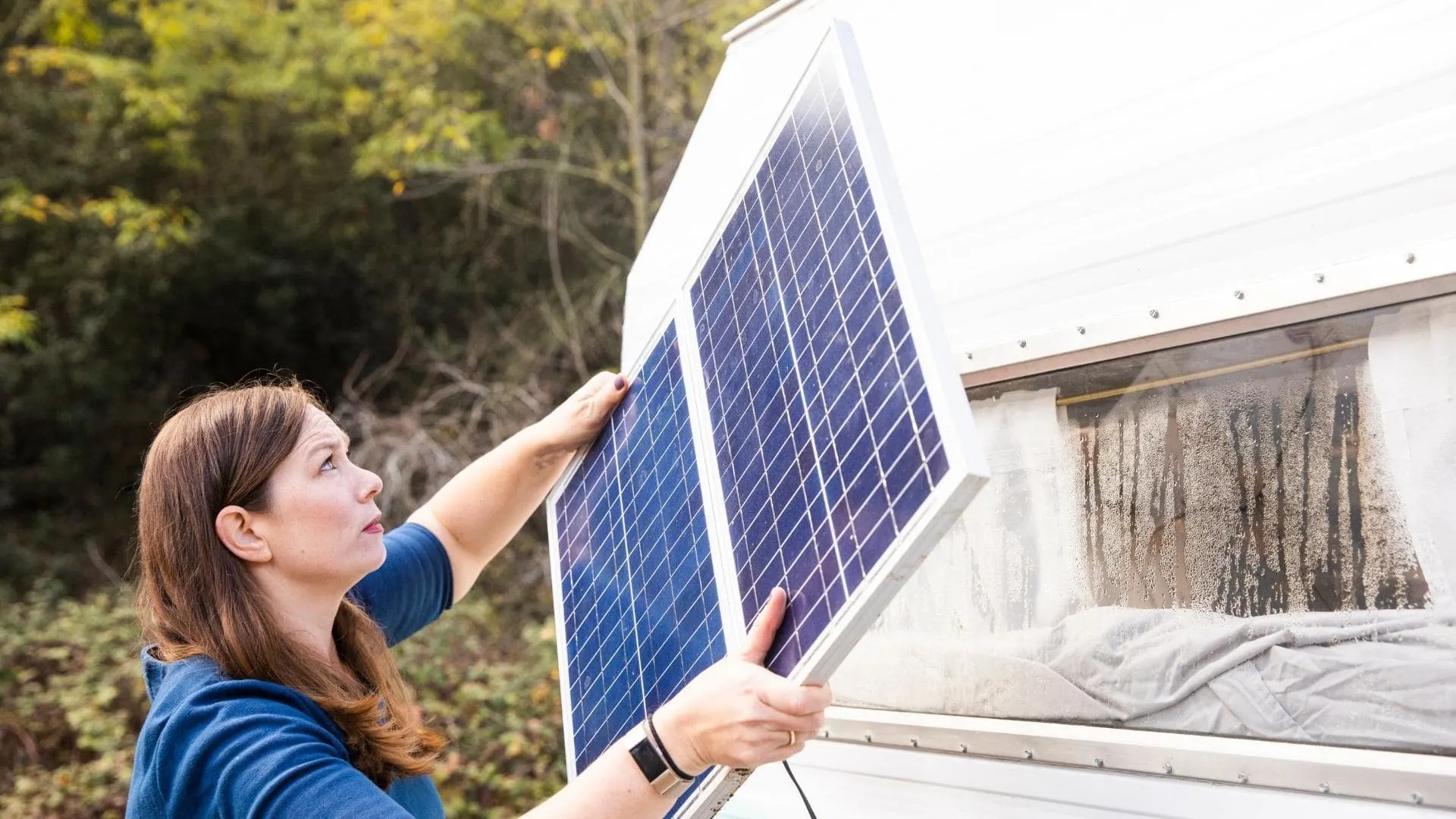
If you can afford even a small solar panel, solar is a great way to keep your batteries charged. You can either install one or two, or you can buy a portable solar panel and set it out in the sun while you’re camping.
What to Look for in the Best RV Battery for Boondocking
Let’s take a look at a few things you’ll want to consider when shopping for RV batteries for boondocking.
Voltage
RV batteries generally come in one of two voltage ratings – 6V or 12V. 12V batteries are larger, and many RVers have boondocked just fine with a single 12V battery. Many Class B RVs, in fact, were once manufactured with a single 12V house battery.
As power needs have increased over time, we’re now more likely to see at least two 12V batteries wired into the system of many RVs. More than one 12V battery can be connected together, though they are fairly large and quite heavy, and if your rig wasn’t made to accommodate two 12V batteries, you’d need to make sure they’ll fit.
Many RVers choose instead to wire a couple of 6V (golf cart) batteries together to reach the voltage needs (12V) of an RV and to fulfill their power needs. The advantage of doing this is that 6V batteries have larger, thicker lead plates that allow them to withstand the stresses associated with the discharge-recharge cycle. This is why they are commonly referred to as “deep cycle batteries”. Pairing them up in series to make one larger 12V battery results in a longer life under heavier use.
Capacity
Capacity is another consideration when shopping for the best RV battery for boondocking. The capacity of a battery refers to the amount of energy – or the number of amps – a battery can provide until its capacity is depleted to the degree that it needs to be recharged.
When you see a reference to Ah (amp-hours), this indicates the power a battery can provide to power your electrical devices. The standard rating for deep-cycle batteries is based on how many amps you can pull out of the battery over a 20-hour period.
So, for a 100 Ah rated battery, this means you can draw from the battery for 20 hours, and it will provide a total of 100-amp hours of power. That translates to about 5 amps (5A x 20 hours = 100Ah).
Previously, in the section asking how many amp-hours a camper would need for boondocking, we talked about how it’s important to figure out what appliances and devices are important for you to be able to use throughout a day of camping. This is what capacity is all about – and the more battery capacity you have, of course, the more appliances and devices you can run, (or the longer you can run them).
Always budget for a larger capacity battery than you calculate needing.
Discharge Rate
The discharge rate refers to the rate at which your RV’s electrical devices draw power from the battery. Batteries have varying capabilities when it comes to discharge rates. And the rate at which you discharge your batteries can affect their ability to provide you with their stated capacity.
For lead-acid batteries (flooded, AGM, and gel), Peukert’s Law states that the relationship between the total time of discharge and the applied load is not linear. This means that as your load increases (i.e. you’re drawing more amps), your realized capacity from your battery decreases (you won’t get as many amp-hours of power).
For consistency, battery manufacturers use a 20-hour rating when determining their battery’s capacity. That means a battery with a 100 Ah capacity will provide that rated amount of power if you use a 5-amp load (5A x 20h = 100Ah).
But if you discharge a 100 Ah battery by drawing 100-amps of load, it won’t provide you with one hour of runtime, because of Peukert’s law.
For a more detailed demonstration of all this, watch the following video:
Lithium batteries are significantly less affected by Peukert’s Law and, as a result, can supply most of their rated capacity, even when subjected to higher loads.
What Are the Best RV Batteries for Boondocking?
As we mentioned above, there are a number of factors that will determine which is the best RV battery for boondocking… for you! Let’s take a look at some of the best brands and models of RV batteries for boondocking that are on the market today.
IMPORTANT NOTE: if you’re planning to switch from one type of battery to another (particularly from any lead-acid battery to lithium), check to be sure that all of your charging-related system components are compatible with the new battery type. You may have other items (converter/charger, inverter/charger solar charge controller(s), chassis battery charge combiner/maintainer, etc) to upgrade as well. Otherwise, you’ll risk damaging the new battery(ies).
Battle Born LiFePO4 Deep Cycle Battery
Battle Born quickly established a reputation in the RV industry as a manufacturer of high-quality lithium-ion batteries. These batteries are expensive, but they’re efficient, durable, and long-lasting.
Battle Born batteries charge quickly and efficiently, are lightweight, and are backed by Battle Born’s 10-year warranty. When you consider the number of flooded lead-acid batteries you’d have to buy over a 10-year period to match the power output and efficient recharging of a Battle Born LiFePO4 deep cycle battery, the Battle Born battery’s sticker shock wears off quickly.
They are available both directly from Battleborn’s website and on Amazon:
- Up to a Decade of Use - Enjoy superb return on your investment with this heavy duty 100Ah 12V LiFePO4 battery! This 100Ah 12V lithium battery lasts...
- Built for Rugged Adventures - Our fast-charging LiFePO4 100Ah 12V batteries are the perfect camper, van, boat, trolling motor, and lithium RV battery....
Xantrex 12V Lithium-Ion Battery
Xantrex, long a leader in the industry, offers 12V drop-in lithium-ion batteries in a couple of different capacities. The Group 27 size offers 105Ah and the slightly larger Group 31 provides 125Ah. (Xantrex makes much larger capacity batteries as well, like the eGen model we have installed in our RV, but they’re also significantly larger in size.)
These 12V drop-in batteries at 105Ah and 125Ah can be stacked four batteries in parallel to create a much larger capacity (Ah) system that may be more likely to fit in your RV’s battery bay. They come with Bluetooth connectivity, which enables you to monitor their status via the Xantrex app on your smart device, there’s an (optional) remote panel for monitoring/controlling them, and you can order them with internal heating so they can be charged in freezing temps.
The batteries are IP65 rated, and tested to UL 458 vibration standard for marine applications, so they’ll withstand the bouncing an RV provides, even over off-road terrain.
https://xantrex.com/power-products/lithiumion/105ah_lithiumion.aspx
https://xantrex.com/power-products/lithiumion/125ah_lithiumion.aspx
Fullriver 6V AGM Battery
Fullriver Group makes a 6V 224Ah AGM sealed lead-acid battery that is highly rated. This fully sealed, maintenance-free 6V battery can be mounted on its side if necessary… but at 6V must be paired in series with a second battery to generate the 12V your RV will require.
Fullriver offers a 5-year warranty on its 6V AGM batteries, with free replacement for the first 24 months, prorated for the next 36 months.
- 6 Volt Deep Cycle AGM
- Maintenance Free Battery BCI GROUP GC2
Optima OPT8016-103 Batteries D34M BlueTop Starting and Deep Cycle Marine Battery
A less expensive but still high-quality battery for RV boondocking is the Optima Blue Top deep cycle marine battery. This is a 55Ah battery, so clearly far less capacity than the three batteries mentioned previously, but Optima has a long-standing reputation for quality, durable batteries and may suit your application for far less cash than the others.
Optima’s Blue Top is a small but heavy battery at 43 pounds, is spill-proof, maintenance-free, and can be installed in virtually any position. Its significant vibration resistance makes it a perfect (and popular) choice for marine and RV applications.
- 12-Volt, 750 Cold Cranking Amps, Size: 10 inches x 6 7/8 inches x 7 13/16 inches tall, Weight: 43.5 pounds, Dual SAE & 5/16 inches Stainless Steel...
- Optimal starting power even in bad weather
VMAX XTR6-235 6Volt 235ah AGM Golf Cart Battery
This VMAX 6V battery has a 235Ah capacity and a reputation for efficiency and durability. It’s heavy, weighing in at 78 pounds (nope – that’s not a typo – this 6V battery weighs 78 pounds).
If you’ve got the space and the cash and your rig can safely bear the weight, these batteries can be paired (in series to create 12V) or quadrupled (series-parallel) for a very significant capacity of reliable battery power.
No products found.
Trojan T-105 GC2 6V Deep Cycle Flooded Lead Acid Battery
And finally, Trojan’s T-105 6V deep-cycle flooded lead-acid battery is often touted as the best flooded lead-acid battery on the market.
Each T-105 6V battery has a capacity of 225Ah, and joined in series with another Trojan T-105 should give most RVers looking for a high-quality flooded lead-acid candidate plenty of power for boondocking.
Note that each Trojan T-105 weighs 64 pounds.
We’d be remiss not to mention that although we’re providing the Amazon link to the Trojan T-105, Amazon’s price is too high for this battery, so if you have an interest in Trojan batteries, you may want to consider looking at other purchasing options.
No products found.
Enjoy Your Time Camping Off the Grid
Boondocking is an experience well worth trying. The majority of people who try boondocking enjoy it immensely.
No matter how you power your RV – even if you have a single house battery or a small solar generator – give boondocking a try, and enjoy your time camping off the grid!
Geek Out With Us Every Week
Join our newsletter to learn about all things RV-related. Every week we offer free tips, tricks, product reviews, and more to our online community of RVers. So, whether this is your first time on the road or you’re a seasoned expert, we’d love for you to geek out with us!


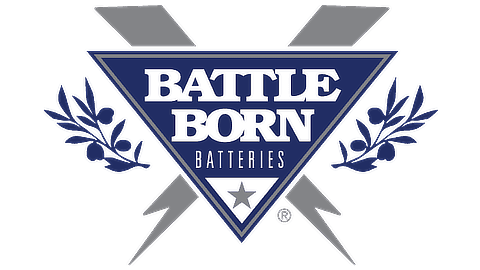



AK Fish
Saturday 27th of January 2024
FYI, XANTEX Li-ion batteries don't have battery heaters: During cold temperature RECHARGE, if the internal cell temperature is below freezing the Xantex Battery BMS will DISCONNECT the cells from the terminals until the internal temperature has risen ABOVE 37 °F (3 °C). This will prevent damage to the cells.
The XANTEX batteries will DISCHARGE down to -4 F BUT they won't RECHARGE until internal temp is above 37 F. If you have them in heated area, then cold temps are a non-issue.
Greater than 3 mo. storage (typical for most non-full time RV'rs) - XANTEX Storage and Maintenance-Instructions for Long Durations: 1. Reduce the battery state-of-charge (SoC) to 50% ±10%. 2. Turn off the battery using the ON/OFF button. 3. Keep the battery in an environment according to Battery Maintenance and Storage Specifications.(50-77 F) 4. EVERY THREE MONTHS maintain the battery by charging it to 100% SoC, THEN DISCHARGING the battery to low voltage cutoff (LVC) level (10.0V for XANTEX), THEN CHARGING it back to 50% ±10% SoC.
So there is a bit more to lithium battery ownership & extending battery life than: disconnect, turn it OFF, store it with a battery trickle charger appropriate for Li-ion batteries and forget about it. Read the owner's manual for the do's and don'ts unique to that battery.
BTW: I use sealed no-mainteance lead acid 12V batteries with a roof mounted solar panel & a portable generator for backup when solar is not ideal (in the woods, cloudy days, after sunset) for recharging. This is ideal for my style of camping.
TheRVgeeks
Wednesday 31st of January 2024
Couple of points of clarification... Xantrex does offer a heating blanket accessory for the drop-in style (105Ah & 125Ah models) batteries that plugs into the battery and turns on/off as needed based on ambient temp.
And as for the instructions for storing long term... every battery manufacturer has slightly different recommendations. Battle Born basically says to charge them up to a state of charge above 50% and disconnect them. That's all. Xantrex is a very engineering-focused company, and we'd suspect that their recommendations are based on the absolute best way to ensure the maximum lifespan for their lithium batteries. Which isn't a bad thing, considering that lithium batteries are still fairly pricy (though, due to their lifespan, their TCO (Total Cost of Ownership) isn't actually so bad... you're just having all the outlay upfront, instead of replacing your lead-acid battery bank multiple times over the same span of time).
Rob
Saturday 28th of January 2023
Started out with 12 volt Marine batteries when we began RVing in tent Trailer. Many years and many up grades to the Class A Motorhome we have now. We have settled on AGMs. For the amount we use our MH and what we use it for they were the best bet. Copying some RV modifications by RV with TITO. We were able to add a second bank of batteries to our MH. Knowing what u need is key to the decision on what batteries to use. Safe travels.
TheRVgeeks
Saturday 28th of January 2023
All great points, thanks for sharing Rob!
BL Armstrong
Thursday 10th of March 2022
I’m a newbie to RVing and just bought a 2013 fifth wheel. The lead acid battery in the trailer was old and since I will be off grid (purchasing a generator) I’ve purchased a LiFePO4 battery to drop into the trailer.I’m confused now if the converter/charger in the rig can charge and convert the lithium battery. Do I have to upgrade/replace the old converter to work with the lithium battery? I thought I could just swap out the lead acid. Any direction would be helpful. Thank you
TheRVgeeks
Thursday 10th of March 2022
Hi BL. As we mentioned in the article above, you definitely have to check to be sure your other electrical components are Lithium compatible... in this case, your converter/charger (if you have solar, you'll also have to check your solar charge controller, etc). Find the make & model on your converter/charger and check with the manufacturer. It will likely need to be configured to switch to Lithium-compatible mode... or be replaced.
Unfortunately, too many Lithium battery manufacturers like to gloss over that compatibility issue and market themselves as "drop-in replacements" for flooded lead-acid batteries. While they may match the dimensions, making them an easy PHYSICAL switch out, their electrical/charging properties are different enough to cause problems.
Trevor
Saturday 29th of January 2022
Very thorough article on batteries and battery types. It's important to recognize that the RV battery management system (charger) needs to be matched to the battery type in use also.
TheRVgeeks
Sunday 30th of January 2022
Excellent point, Trever. We've added a note about that to the article.
Trevor
Saturday 29th of January 2022
Great article, Just want to dispel the concrete floor issue. Batteries are not harmed by concrete floors , "old wives tale " that doesn't seem to die :( . Check out this link: https://www.mcgill.ca/oss/article/general-science-you-asked/concrete-truth-about-batteries-stored-concrete. Keep up the good articles!
TheRVgeeks
Sunday 30th of January 2022
Thanks for catching that, Trevor. That reference has been removed (from the article AND our brains, LOL!).